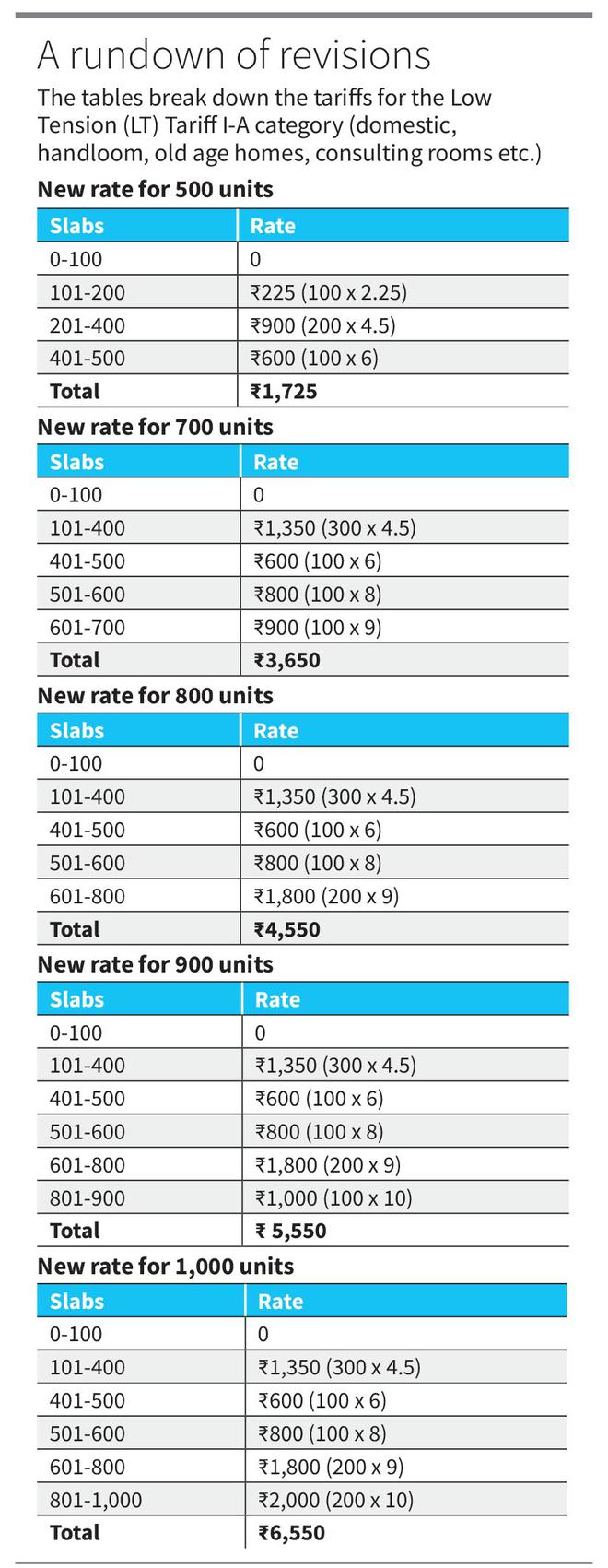Even as most of the people of this State are yet to fully absorb the finer details of the Tamil Nadu Electricity Regulatory Commission’s latest general tariff increase, the main message is nevertheless crystal clear: they will be paying higher electricity bills than they have paid in the past, regardless of the quality of service.
E. Chandra, who owns a petty shop in Madurai, is among many people who are worried about the increase. She is anxious about how she can repay loans because a chunk of her meagre earnings will go towards the power bill. Already, the view gaining ground is that domestic category users who consume 500 units and above bimonthly will be the worst affected. The new rate for those using 500 units bimonthly would be ₹1,725 against the old rate of ₹1,140, an increase of 51.32%, a figure confirmed by Electricity Minister V. Senthilbalaji himself in an advertisement issued to a Tamil daily on September 15.
Raghavan, a resident of Nanganallur, a Chennai suburb, complains about this category being made “victims” of the free universal supply of 100 units for every two months to the domestic category. However, in the calculation of the authorities, the segment, totalling around 7.2 lakh, accounts for a mere 3.03% of the 2.37 crore domestic and hut connections. S. Subramaniam, who resides at Ammapettai near Chidambaram in Cuddalore district, raises the issue of faulty meter readings; he says most meters are “sub-standard”. Besides, the readings are not done properly. Terming public hearings held by the TNERC eyewash, N. Jamaludeen of Tiruchi is sore that Tangedco did not bother to listen to the grievances and points made by the consumers. “A close look at the new tariff structure shows that the domestic connections have almost been brought on a par with the commercial category, but for fixed charges,” he points out.
The micro, small and medium enterprises (MSMEs) are the next to express disapproval of the increase. Tamilnadu Small and Tiny Industries Association (TANSTIA) president K. Mariappan, in a letter to the Electricity Minister on September 19, contended that “the enhanced power tariff is a real challenge and practically paralyses the production activities of MSMEs,” which were facing unexpected difficulties from the impact of the COVID-19 pandemic in the last two years. Most enterprises “have been sick and have even become non-performing assets and most of the financial institutions are threatening to invoke the SARFAESI [Securitisation and Reconstruction of Financial Assets and Enforcement of Security Interests] Act by forcibly taking symbolic possessions.”
Advocating the cause of MSMEs, K.E. Raghunathan, national chairman of the Association of Indian Entrepreneurs and a member of the State Advisory Committee of TNERC, says the sector is also facing pressure from the increase in raw material costs. “They have to first return to profitability, which will take time.” Calling for the tariff increase to be reconsidered, Mr. Raghunathan feels the increase goes against Chief Minister M.K. Stalin’s plan to promote small and medium units. “It is important to protect the entrepreneurs in the State,” he adds.

The change in the definition of peak hours has been questioned by the MSMEs and general consumers alike. S. Ashok, president, Tamil Nadu Electricity Consumers Association, points out that no proper explanation has been given by Tangedco for revising the morning peak hours to 6 a.m. to 10 a.m. from 6 a.m. to 9 a.m. and the evening peak hours to 6.00 p.m. to 10.00 p.m. from 6.00 p.m. to 9.00 p.m., apart from increasing the peak hour charges from 20% to 25%.
TANSTIA, which held discussions with the Minister on September 15, has demanded the total withdrawal of the new peak hour norm. It has also suggested a reduction in the fixed charges (coming under the category of low tension), which are payable per kilo watt (kW) per month. In the case of high tension (HT) consumers, it has said the demand charge should be based on consumption instead of standard cost.
Gunasingh Chelladurai, president, Tirunelveli District Chamber of Commerce and Industry and a partner in Standard Fireworks, says the cost of chemicals required for making firecrackers has increased by ₹1,500 a tonne. “So, the end consumer will have to bear the substantial cost of this unprecedented increase in power tariff, though we cannot hike the price of our products exponentially.”
A HT consumer, who owns a multi-utility complex in Tiruchi having a demand of 550 kVA (kilovolt amperes), says he will have to pay every month ₹3,02,500 as against ₹1,92,500 on account of demand charge. On the impact on commercial establishments such as hotels and textile showrooms, Prabhu Venkataramani of Hotel High Point in Tiruchi says, “As per a conservative calculation, the hike in power tariff will be 55% to 65%. No doubt, this will put us under severe pressure. The steep hike is unexpected, especially when traders and businessmen are still struggling to overcome the impact of COVID-19.”
During September 16-23, over one lakh job-working power loom units in Coimbatore and in part of Tiruppur observed a strike to protest against the hike. They have decided not to pay the revised tariff. A Coimbatore textile mill owner (HT consumer) says that if a textile mill runs at 90% capacity utilisation, the increase in tariff for one unit of power will be only ₹1 and it will increase the cost of yarn by ₹6 a kg. At present, most of the mills are operating just one shift and because of lower capacity utilisation, the energy cost will increase nearly by ₹3 a unit.
Voices of approval
However, there are some voices of approval for the tarifff increase even among members of the public. Indicating that the tariff increase is inevitable, a farmer in Cumbum of Theni district says that had the governments increased the tariff periodically in the past, such a hue and cry could have been avoided this time. Possibly, keeping this factor in mind, TNERC cleared Tangedco’s proposal for an annual increase of up to 6%.
The government’s response to the criticism has been one of explaining the rationale behind the increase and pointing out that the tariff is still lower in Tamil Nadu than in many other States for certain categories of consumers. The government has been emphasising that around 40% of the domestic and hut connections, numbering 1 crore, have been left untouched. Also, there is no change in the free supply of 100 units bimonthly to all domestic consumers. The fixed charges of ₹20 to ₹50 bimonthly for 2.37 domestic consumers have been withdrawn, and this is in line with one of the assurances made in the ruling DMK’s manifesto for the 2021 Assembly election. Apart from free supply to huts and for agriculture, the subsidy scheme for power looms and hand looms will continue.
Officials point out that an attempt has been made to adopt a more benign approach towards HT industrial units in view of the sector’s importance to the State’s economy in terms of employment and revenue generation. This is why an average of a 10.6% increase has been effected. In the case of LT commercial establishments, the range is from a minimum of about 18% to a maximum of 25%.
The officials also refer to an additional affidavit filed by Tangedco about 10 days prior to the issue of the tariff order, addressing certain concerns of the industry and commercial establishments. For example, in the case of LT industries, the fixed charges per kW per month were reduced from ₹100 to ₹75 for the 0-50kW slab; ₹325 to ₹150 for 50 kW-100 kW; ₹600 to ₹150 for 100-112 kW and ₹600 to ₹500 for over and above 112 kW. This would benefit 3.37 lakh consumers, Rajesh Lakhoni, Chairman and Managing Director of Tangedco, said in a tweet on September 11. Another of his tweets talked about the concession for LT commercial establishments, benefiting around 17.3 lakh connections.
Alternative options
However heavy the impact of the increase may be, there seems to be a muted response among domestic users to alternative options such as rooftop solar power plants. This is not confined to them. C. Balasubramanian, former president of the Indian Chamber of Commerce and Industry, Coimbatore, says a large number of commercial establishments, having their shops in multi-storey complexes, may not have enough space on their premises. Besides, they cannot afford the steep installation charges.
The reason is not far to seek. Solar power needs huge capital investment. Describing the situation of users thinking of installing rooftop systems as that of those caught between the devil and the deep sea, Mr. Raghunathan, a veteran in the solar energy field, explains that the high cost is due to the rise in customs duty, the ban on Chinese solar modules and several solar installers closing the shop during the pandemic. Also, the removal of subsidy and delay in getting net meters would put off the consumers. The “on grid” system is still viable in the present scenario in which the consumer would not be able to evacuate excess energy to the grid, whereas the “off grid” system with net metering has become costly.
Notwithstanding certain demerits, the installation of rooftop solar systems can be an alternative option, says another group of experts. The Union Ministry of New and Renewable Energy, under the grid-connected Rooftop Solar Scheme (Phase-II), is providing a 40% capital subsidy for the first 3 kW and a 20% subsidy beyond 3 kW and up to 10 kW. The Ministry has created a portal ‘solarrooftop.gov.in’ to implement the scheme. However, this has not been fully implemented in Tamil Nadu as on date, the experts contend.
P. Muthusamy, former Director (Engineering), TNERC, points out that without subsidy, the generation cost works out to around ₹6 per unit. In addition, domestic users have to pay ₹0.29 per unit towards network charges, as recently revised by TNERC. According to Muthusamy, the rooftop solar systems may benefit only those whose bimonthly demand exceeds 500 units, for which the new rates begin with ₹8 per unit and go up to ₹11.
The pros and cons of the tariff increase apart, there are sections of consumers who would not mind paying higher charges if the power utility ensures better services, an area that requires the urgent attention of those who matter in the government. Besides, instead of waiting for the State-wide application of the idea of smart meters and citing the possible opposition from assessors, Tangedco would do well to revert to the monthly billing cycle, consumers suggest. This would not only reduce the pressure on their pockets but would also mark the implementation of another electoral promise of the ruling party.
(With inputs from P. Sudhakar in Tirunelveli, L. Srikrishna in Theni and Ramanathapuram, S. Sundar and B. Tilak Chandar in Madurai, M. Soundariya Preetha in Coimbatore, C. Jaisankar in Tiruchi, S. Prasad in Cuddalore, and Sanjay Vijayakumar, R. Srikanth and Sangeetha Kandavel in Chennai.)







